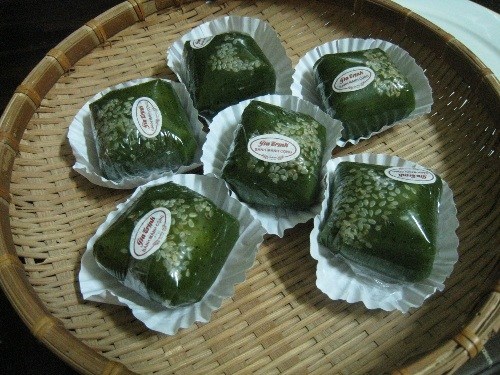“Bánh mảnh cộng” cake made by Gia Trinh who are specialized in making traditional cakes
Making “Bánh mảnh
cộng” isn’t very difficult. Blend the Clinacanthus nutans leaves then use
the juice to mix with sticky rice flour. Coconut is sliced into small strands
and mixed with green beans and sugar then placed in the middle. The mixture of
green bean, coconut, sugar brings a taste of sweetness and the fat to the dish.
This mixture is wrapped in a layer of sticky rice that is green in color and
smells of Clinacanthus nutans leaves. The cake is formed into a round shape and
wrapped in banana leaves before steaming.
After steaming the cake needs to be left to cool down,
the aroma leaves a warm feeling for everyone. After tasting, the flavor of the
sticky rice, leaves and green beans stayed on my tongue and brought back
childhood memories.
Mrs Ha Thi Hong Phan lives in Hang But St and recalled
the old days when her mother used to make cakes such as “Bánh gấc” or “Bánh mảnh cộng”.
She was less than 10 years old at that time but still wanted her mother to
teach her how to make them. “Bánh gấc”cake
was also made by a little girl named Hong Ha, it was very delicious, it had
good moisture and a very good aroma. This passion for making traditional cakes
has followed for decades. Hong Ha is now the owner of a famous bakery in Hanoi.
When you have a passion for traditional cakes you can’t
ignore the ingredients. Mrs Hong Ha brings leaves from Clinacanthus nutans,
Gnaphalium affine and Boehmeria nivea, together with Gardenia jasminoides Ellis
flowers and Momordica cochinchinensis fruit from her hometown to the city. When
there are not enough natural ingredients she grows them herself. All the cakes
are made with new flour, fresh leaves, flowers and fruits. These cakes have a
good smell of new sticky rice, new leaves and fresh green beans. Each of these small pieces of cake contains memories
of Hanoi from the old days.

Recently, Mr Hai Phuong Nguyen rediscovered recipes and
cooking methods for “Bánh mảnh cộng”
and asked food experts sample it to see if it maintained its authentic flavor.
After receiving comments from senior chefs and elderly people he returned home
and practiced again. He repeated the processes 10 times before he could finally
make “Bánh mảnh cộng” with its typical green color, the correct moisture and
aroma, and the rich taste of green beans. It also had the smoothness which is
critical in making “Bánh mảnh cộng”
"When cuisine
carries cultural factors, it represents the manners and morals of a
nation". Sometimes the simple things in life such as what you eat or
drink, is the source of life .
Happiness comes when the old traditions are preserved.
This simple thing means we are also preserving the roots of our hometown
and our country?
Followed
by V.H
Dan Tri Newspaper
Extracted
from articles written especially for Golden Spoon Contest 2014 called “A journey
to search for traditional rustic dishes”